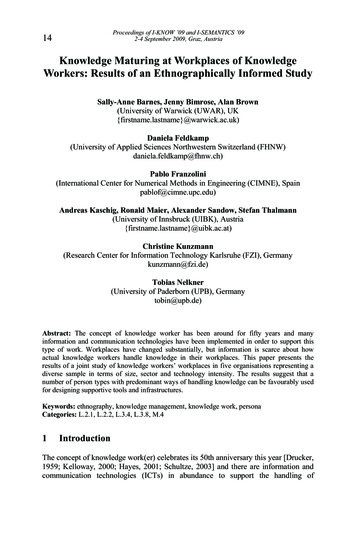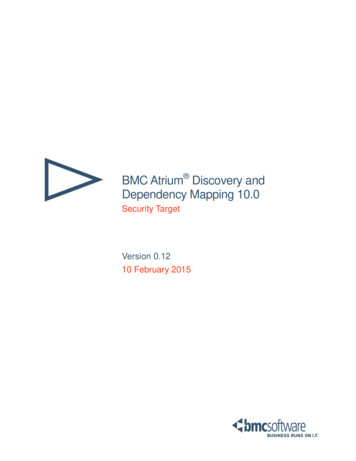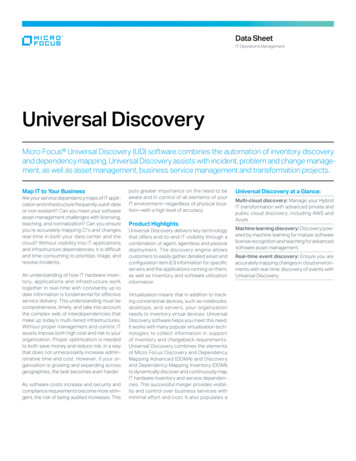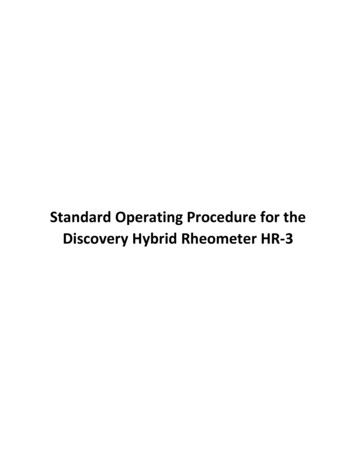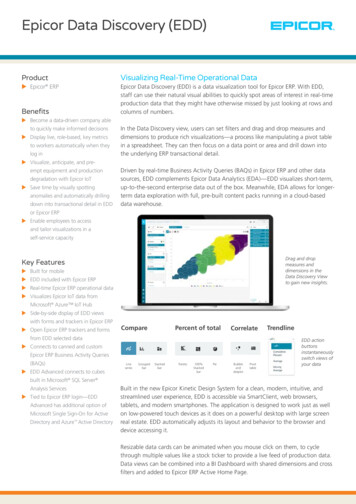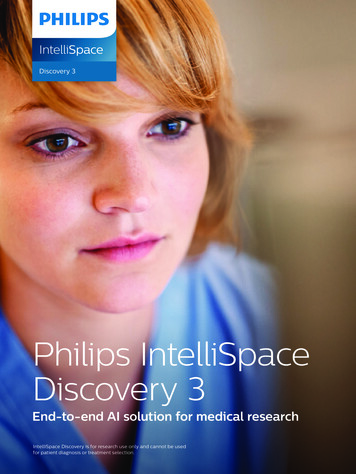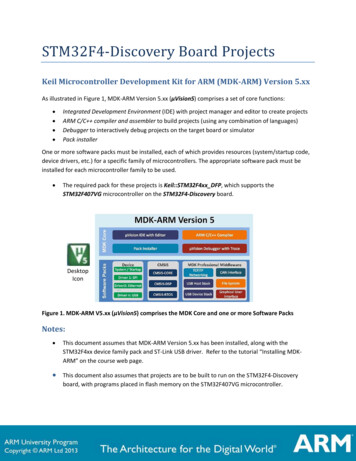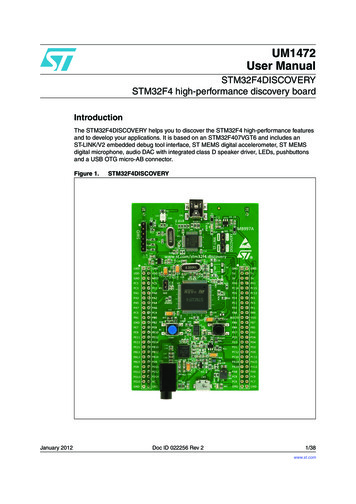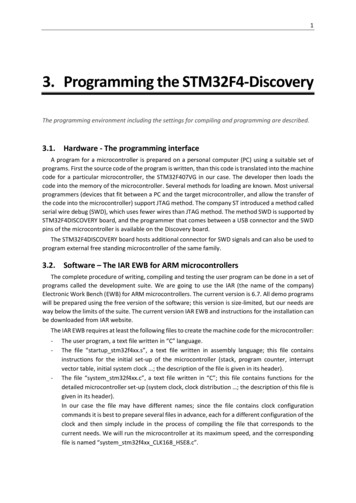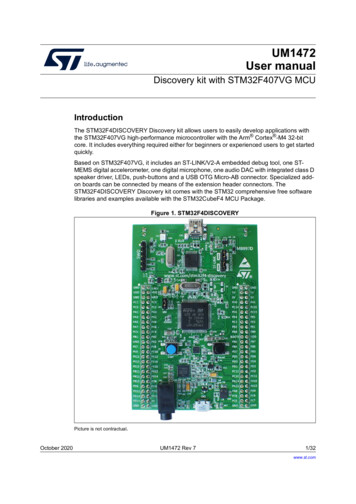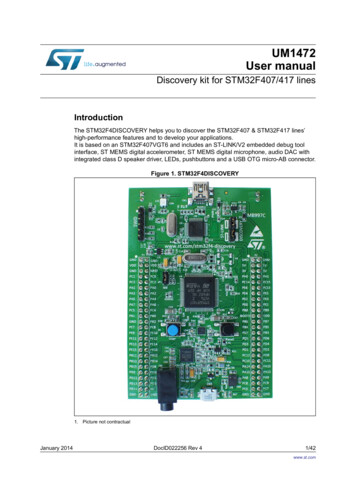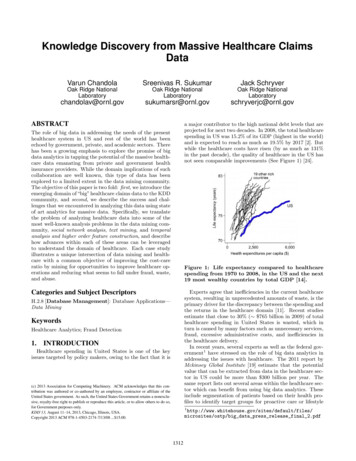
Transcription
Knowledge Discovery from Massive Healthcare ClaimsDataVarun ChandolaSreenivas R. SukumarJack SchryverOak Ridge NationalLaboratoryOak Ridge NationalLaboratoryOak Ridge .govschryverjc@ornl.govABSTRACTa major contributor to the high national debt levels that areprojected for next two decades. In 2008, the total healthcarespending in US was 15.2% of its GDP (highest in the world)and is expected to reach as much as 19.5% by 2017 [2]. Butwhile the healthcare costs have risen (by as much as 131%in the past decade), the quality of healthcare in the US hasnot seen comparable improvements (See Figure 1) [24].The role of big data in addressing the needs of the presenthealthcare system in US and rest of the world has beenechoed by government, private, and academic sectors. Therehas been a growing emphasis to explore the promise of bigdata analytics in tapping the potential of the massive healthcare data emanating from private and government healthinsurance providers. While the domain implications of suchcollaboration are well known, this type of data has beenexplored to a limited extent in the data mining community.The objective of this paper is two fold: first, we introduce theemerging domain of “big” healthcare claims data to the KDDcommunity, and second, we describe the success and challenges that we encountered in analyzing this data using stateof art analytics for massive data. Specifically, we translatethe problem of analyzing healthcare data into some of themost well-known analysis problems in the data mining community, social network analysis, text mining, and temporalanalysis and higher order feature construction, and describehow advances within each of these areas can be leveragedto understand the domain of healthcare. Each case studyillustrates a unique intersection of data mining and healthcare with a common objective of improving the cost-careratio by mining for opportunities to improve healthcare operations and reducing what seems to fall under fraud, waste,and abuse.Figure 1: Life expectancy compared to healthcarespending from 1970 to 2008, in the US and the next19 most wealthy countries by total GDP [14].Categories and Subject DescriptorsExperts agree that inefficiencies in the current healthcaresystem, resulting in unprecedented amounts of waste, is theprimary driver for the discrepancy between the spending andthe returns in the healthcare domain [11]. Recent studiesestimate that close to 30% ( 765 billion in 2009) of totalhealthcare spending in United States is wasted, which inturn is caused by many factors such as unnecessary services,fraud, excessive administrative costs, and inefficiencies inthe healthcare delivery.In recent years, several experts as well as the federal government1 have stressed on the role of big data analytics inaddressing the issues with healthcare. The 2011 report byMckinsey Global Institute [19] estimate that the potentialvalue that can be extracted from data in the healthcare sector in US could be more than 300 billion per year. Thesame report lists out several areas within the healthcare sector which can benefit from using big data analytics. Theseinclude segmentation of patients based on their health profiles to identify target groups for proactive care or lifestyleH.2.8 [Database Management]: Database Applications—Data MiningKeywordsHealthcare Analytics; Fraud Detection1.INTRODUCTIONHealthcare spending in United States is one of the keyissues targeted by policy makers, owing to the fact that it is(c) 2013 Association for Computing Machinery. ACM acknowledges that this contribution was authored or co-authored by an employee, contractor or affiliate of theUnited States government. As such, the United States Government retains a nonexclusive, royalty-free right to publish or reproduce this article, or to allow others to do so,for Government purposes only.KDD’13, August 11–14, 2013, Chicago, Illinois, USA.Copyright 2013 ACM 978-1-4503-2174-7/13/08 . es/microsites/ostp/big data press release final 2.pdf1312
changes, development of fraud resistant payment models,creating information transparency and accessibility aroundhealthcare data, and conducting comparative effectivenessresearch across providers, patients, and geographies.Healthcare insurance claims have the potential of answering many of the questions currently faced by the healthcaresector, In fact, until shareable electronic health records become a reality, healthcare claims, especially from organizations with a large spatial and demographic coverage such,which is the case with many of the government run healthinsurance programs in the country, are the most reliable resource for understanding the current healthcare landscape,from conditions, care, and cost perspective. But the transactional format of claims data is not amenable for advanceanalytics that the state of art KDD methodologies have tooffer. In this paper we explore transformations of the healthcare claims data which bridge this gap between the healthcare domain and modern data analytics.We present a study of big data analytics on health insurance data collected by a large national social health insurance program. While previous efforts have used datamining methods for analyzing healthcare claims data withinsmall organizations, we believe that this is one of the first instances where advanced data analytics and healthcare haveinteracted at a national scale. In all, we approximately analyzed 2 billion insurance claims for approximately 45 millionbeneficiaries and over 3 million healthcare providers.1.1Figure 2: Different Types of Healthcare Datathe data for payment errors [12]. Limited efforts exist thathave analyzed the healthcare claims data to understand theinefficiencies in the healthcare system [6], but from the analytics perspective they are limited to simple summary statistics such as population means for various demographics. Inthis paper we explore the application of three advanced KDDtechnologies, viz. , text mining [18], social network analysis[29], and time series analysis [20], all of which have been successful in a variety of applications but have not been appliedat a large scale to healthcare claims data.Domains such as credit card and property insurance havelong studied the issue of fraud identification [4, 10]. Buthealthcare fraud detection has unique characteristics giventhat the actual beneficiary is typically not the fraud perpetrator, which is not the case for other domains. So existingfraud detection methods cannot be directly applied to thehealthcare domain. Most of the existing fraud detection solutions in the healthcare domain are not public, primarilybecause of the fact that the data is highly sensitive and isusually not made available for research and publishing.Our ContributionsIn this paper, we make the following contributions:1. We introduce the emerging domain of health care claimsdata and identify multiple research problems that canbe solved using the existing big data analytics solutions.2. We propose three transformations of the transactionalclaims data which enables application of state of artKDD methodologies in this domain.3.3. We present several approaches to identify and understand the fraud, waste, and abuse in the health caresystem. The potential of each proposed approach isdemonstrated on real claims data and validated usinga true set of fraudulent providers.4. We highlight the unique nature of healthcare data whenanalyzed using methods such as social network analysis and text analysis.2.BACKGROUNDHealthcare data can be broadly categorized into four groups(See Figure 2): Clinical data (patient health records, medical images, lab and surgery reports, etc.) and patient behavior data (collected through monitors and wearable devices) provide an accurate and detailed view of the health ofthe population. But such data, which is increasingly beingstored electronically, can be leveraged in a big data settingonly when the owners (doctors, hospitals, and individuals)share, which, owing to privacy concerns is still limited tobeing analyzed within an organization such as a hospital ora network of hospitals. Pharmaceutical research data(clinical trial reports, high throughput screening results) often face privacy concerns owing to business practices. Inthis paper, we focus on health insurance data, which hasbeen collected and stored for several years by various healthinsurance agencies. While the primary justification for thisdata is to track payments and address fraud, such data alsohas great potential to address some of the other aforementioned issues of the healthcare system. For United States,such data is extremely valuable, given that around 85% ofAmericans use some form of insurance (private or government). Moreover, insurance data is the only source of thecost associated with healthcare which is vital to address theRELATED WORKThe role of big data in healthcare has been well acknowledged across government and industrial sectors23 . But onlya few published studies have analyzed such data [12]. Theprimary reason is the data availability, given that the healthcare claims data has strong proprietary and privacy requirements4 . Moreover, existing studies have considered claimsdata from a payment system perspective and have tp://www.hhs.gov/ocr/privacy/1313
economic challenges associated with modern healthcare system. The strong challenge presented by insurance data onthe other hand is that it is not readily in the form to inferstrong analytic insights into healthcare, besides the paymentmodel. A key contribution of this paper is the transformation of the insurance data into formats that allow applicationof existing analytic tools for knowledge discovery.3.1Speciality 600Providers 4 MHealth Insurance DataDiagnoses 17 KBeneficiaries 50 M 8 KFigure 3: Entities and relationships in healthcareclaims data along with approximate number of entries in each entity set.of double payments for duplicate claims, payments usingan outdated fee schedule, etc. A major cause for abuse isdue to the fact that programs such as Medicare follow aprospective payment system for hospital care, which meansthat providers are paid for services at predetermined rates.Thus if the actual service costs more than the allowed cost,the provider has to cover its losses. If the actual servicecosts less than the allowed cost, the provider keeps the remainder. This drives the providers to charge unnecessary ormore expensive services (also known as upcoding) by makingmore severe diagnosis to safeguard against any losses and tomake profit. Some of the examples listed above, e.g., doublepayment for duplicate claims, can be identified by applyingbusiness rules to the data. For others, such as upcoding ormiscoding providers, there is need for advanced algorithmsthat can analyze the vast amounts of claims data.In the subsequent sections we describe three case studies that were conducted onhealthcare claims and associateddata. The common thread among the studies is the analysisof the behavior and interaction between healthcare providers,which is highly important given that they are the primarydrivers for the wasteful spending in the system.1. Claim information captures the information about theservice transaction including the nature of the serviceand the cost.2. Patient enrollment and eligibility data that capturesdemographic information about the patients (or beneficiaries of the system) and their eligibility for differentservices.3. Provider enrollment data that captures the information about the physicians, hospitals, and other healthcare providing organizations.Health Insurance in United StatesIn the US, approximately 85% of the population has someof form of health insurance. Majority of these individuals ( 60%) obtain insurance through their employer or employerof parent or spouse. Almost 28% of population (83 millionindividuals) is covered under government health insuranceprograms. These include programs such as Medicare, Medicaid, Veterans Health Services, etc.The data managed by each of these programs is at a massive scale. Medicare alone provides health insurance to 48million Americans and covers for hospitalization, out patient, medical equipments, and drugs. There are a few million providers enrolled with the Medicare Provider Enrollment, Chain, and Ownership System (PECOS). In 2011,Medicare received close to 1.2 billion claims (4.8 millionclaims per day) for their fee for service programs. An almostequivalent number of claims were received in the prescription drugs program (also known as Part D). Under Medicaid, more than 60 million individuals received benefits in2009 (one in every five). In the state of Texas alone, thereare more than 0.5 million providers within Medicaid.4. 50 KProceduresThe typical health insurance payment model is a Fee-forservice (FFS) model in which the providers (doctors, hospitals, etc.) render services to the patients and are paidfor each service by the payor or the insurance agency. Theproviders record the details of each service, including thecost and justification and submit the record to the payor.The payor decides to either pay or reject the claim based onthe patient’s eligibility for the particular service which aredetermined by the policy guidelines.The insurance agency typically maintains three types ofdata for their operations:3.2Drugs5.DATAThe data used for the subsequent case studies capturesthree different aspects of healthcare. First is the claimsdata for close to 48 million beneficiaries for the entire US.Second is the provider enrollment data which can beobtained from several private organizations. The third is alist of fraudulent provider
healthcare domain. Most of the existing fraud detection so-lutions in the healthcare domain are not public, primarily because of the fact that the data is highly sensitive and is usually not made available for research and publishing. 3. BACKGROUND Healthcare data can be broadly categorized into four groups
